Arsenal of Japanese samurai (second part)
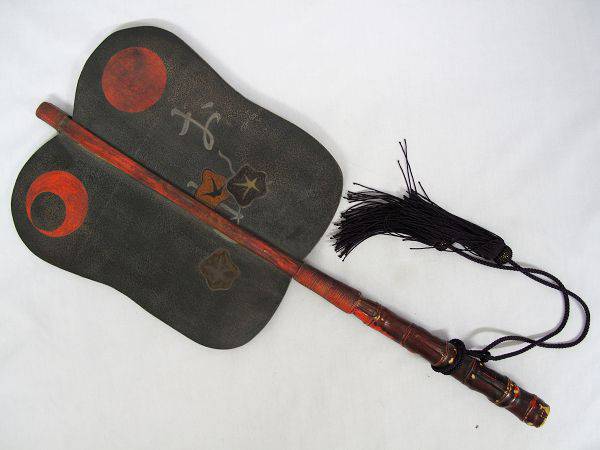
Fighting fan gumbay uchiva. They could give signals, fan themselves, but occasionally repel an arrow or even a sword strike, because it was made of ... iron!
Wooden weapons, who did not have European analogues, were also gekken and yagara-mogara. Gekken had a tip in the shape of a crow's beak and another in the shape of a crescent (turned outward). Gekken allowed the warrior to be captured by the neck and thrown off his horse. Or strike with a poke at the neck, in which there was also little good, even despite the armor. The yagara-mogara (or its variety tsukubo) was a real T-shaped rake, the upper part of which was bound with metal completely bristled with sharp spikes. Such weapons in the arsenal of European knights were not sure, but the samurai did not disdain to use it. True, again, not so much in war as in the peaceful era of Edo, in order to take the criminal alive.
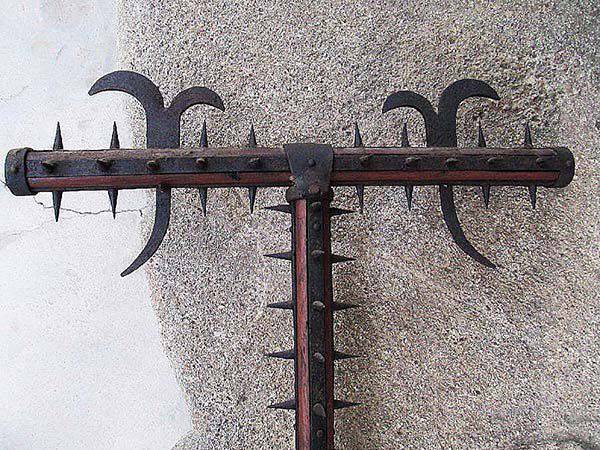
Tsukubo
Special mention also deserves such Japanese weapons as sickles, representing a raven-shaped blade that was fixed to the pole at a right angle. Such a sickle (coma) on a long handle, turned into a very dangerous weapon in skillful hands. The naigama (or roku-shakugama - “six-syaku sickle”) had a shaft up to 1,8 m long, and the o-gama (“large sickle”) - up to 1,2 m. These weapons are often found on figures XII - XIII centuries., And accordingly, they are also mentioned in the chronicles. Used this weapon in order to trim the legs of horses, and in navy as crimsons and even to cut algae, which impeded the movement of boats in shallow water. However, such weapons could be used as a European slander. Toei-noborigama had a length of 1,7 m and a L-shaped top in the form of a narrow ax with a lower edge, sharpened like a sickle. In any case, the same peasants, for example, could very easily arm themselves with such sickles, tying them to long bamboo poles.
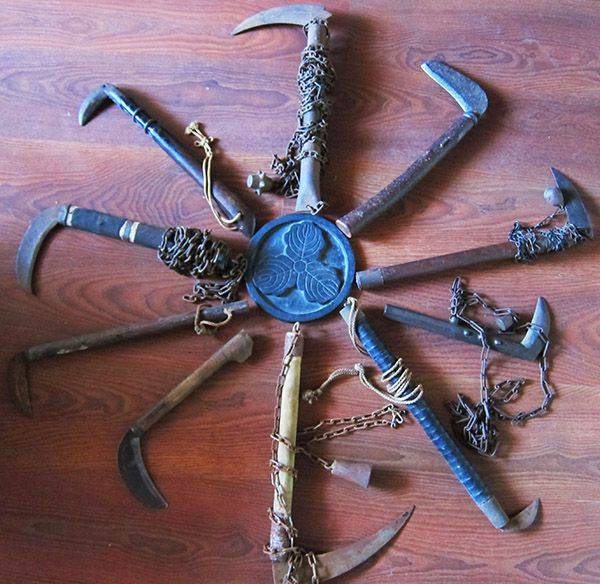
Kusari-gama species
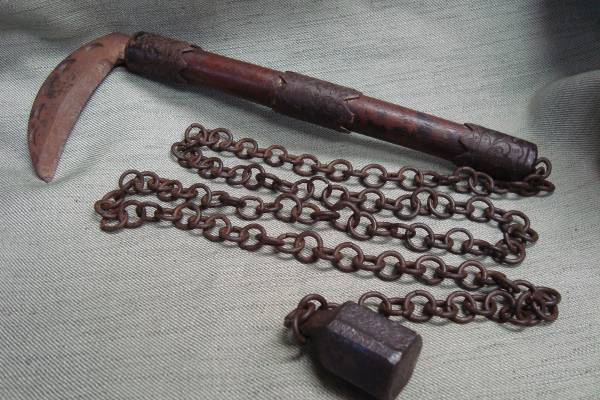
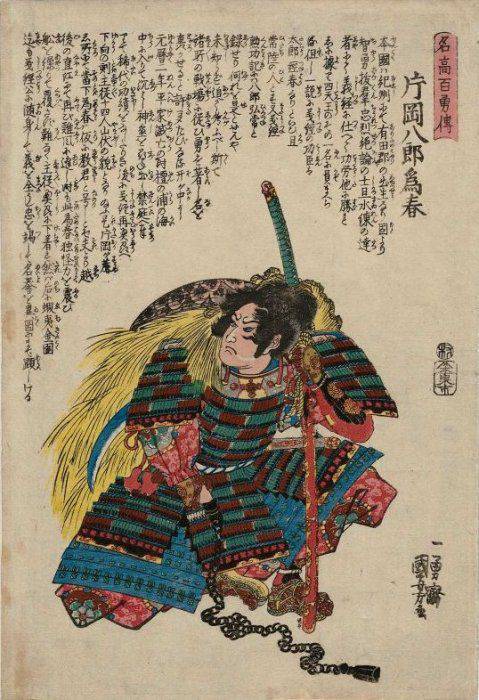
Kataoka Hatiro Tameharu with a chain brush. Woodcut Utagaro Kuniyoshi (1844 g.)
The shafts of short Japanese spears and, like all other weapons, were made of oak, light bamboo was made for long ones. Painted them black or red to match the color of the armor. For the tips - which, by the way, was not typical for Europeans, lacquered sheaths were invented (except that the incredible Mogaras didn’t have a completely unbelievable one for quite objective reasons!), Often inlaid with mother-of-pearl and in addition a cloth cover protecting them from rain . Inlaid mother of pearl and also the shaft in the area of the tip. Including even the sode-garami. And, by the way, it should be noted here that the spears of the Japanese ashigar were the longest in the world (up to 6,5 m!), That is, longer than in Europe, and significantly!
Throwing darts in Japan were also known and, again, many of them were considered just female weapons! For example, a dachi-ute dart about 45 cm long with a feather like an arrow. He was held on special holders above the door. In the event of an attack, it was enough to reach out to grab him and throw!
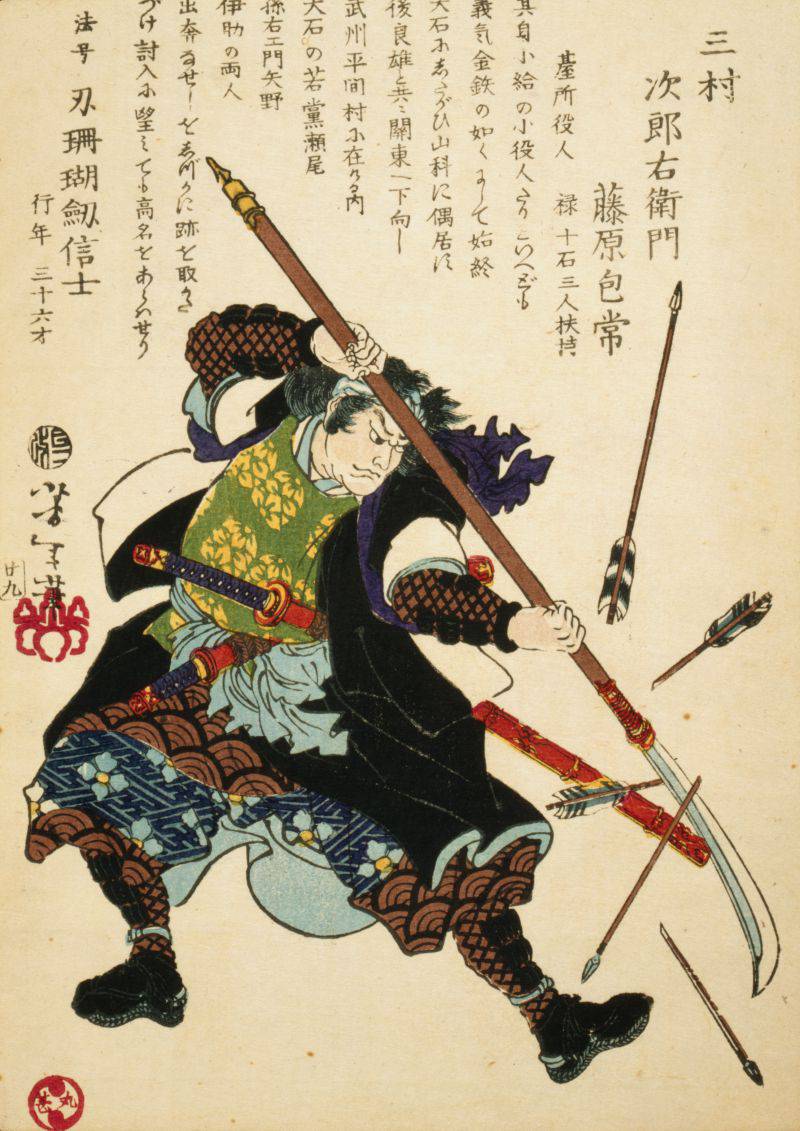
The Japanese believed that the one who skillfully owned such weapons as naginata * could even have reflected the arrows flying at him. Woodcut Tsukioka Yoshitoshi. Library of Congress.
But such a weapon as naginata, firstly, was also considered a sword (although in Europe it would definitely be called a halberd!), And secondly, also a woman's weapon! The samurai’s daughters, when she got married, were given a whole set of such “halberds” as a dowry, and the girls were fencing a course long before marriage. However, women used naginatu and married, although not all, of course. History brought to us the name of Tomoe Gozen - one of the few female samurai who fought with men on a par. So, in the battle of Awaji in 1184, in which she participated with her husband Minamoto Yoshinaki, he, seeing that the battle was lost, ordered her to flee and leave. However, she risked disobeying him and rushed at the enemy. One of the noble samurai she wounded naginata, pulled from his horse, and then pressed to his saddle and cut off his head. Only after that she obeyed the order of her husband and left the battlefield where Yoshinaka himself was killed!
And this is what Heike Monogatari reports about Tomoe Godzen: “... Tomoe was extremely beautiful, with white skin, long hair, and charming features. She was also a skilled archer, and in the battle with swords alone cost hundreds of warriors. She was ready to fight a demon or a god, on horseback or on foot. She had the great ability to tame unbroken horses; unhurt from the steep mountain slopes. Whatever the battle, Yoshinaka always sent her forward as his first captain, equipped with excellent armor, a huge sword and a powerful bow. And she always did more valiant deeds than any other of his troops ... ”
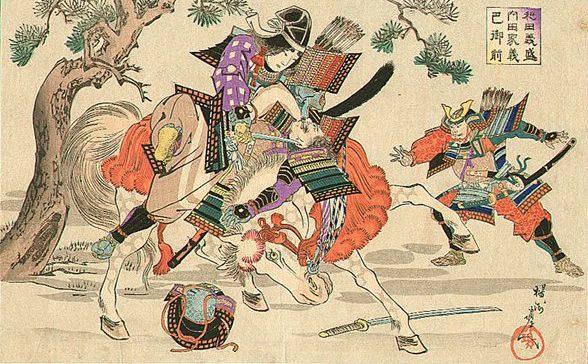
Woodcut Toyohara Tikanobu. Tomoe Gozen cuts off the head of the enemy!
Of course, there were also simply huge naginaty for men, and its heavier variety - bisento with a much more massive blade, which could completely cut off the head, not only man, but the horse. Thanks to their wide scope, with their help, they chopped off the legs of horses, and then finished off the riders after they fell to the ground. Until the end of the Heian period (794 - 1185) it was the weapon of an infantryman and warrior monk (sohei). The noble warriors (busi) rated him during the war Hempmei (1181 - 1185), which became a kind of transitional era between the Heian and Kamakura eras (1185 - 1333). At this time, it is used especially widely, which in a certain way even affected samurai armor. So, the suneate leggings appeared because it was necessary to somehow protect the warrior's legs from this terrible weapon. It also manifested itself during the Mongol invasions (1274 and 1281), and in everyday life naginata played an important role as a weapon with which a woman could protect her home.
An equally important weapon for women was the dagger kaiken, with which they never parted, but hid their kimono in the wide sleeve. It should also be used to protect the family home, but mainly to perform a purely female seppuku in critical circumstances, which was made with a blow of a kaiken to the carotid artery!
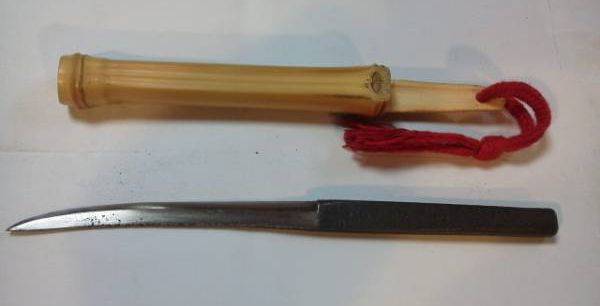
Dagger kaiken - very simple and functional weapon.
However, women from samurai families learned to wield the sword as well, and the cases when they used it in battle are known from history. However, they are also known from historical novels, although it is very difficult to say how much of what has been described corresponds to historical truth. Well, not only women used daggers. There were also samurai in the arsenal, and not only the short blade of the wakizashi pair, which was considered to be not a dagger, but a sword, but also such original “things” as tanto and aiguchi ..
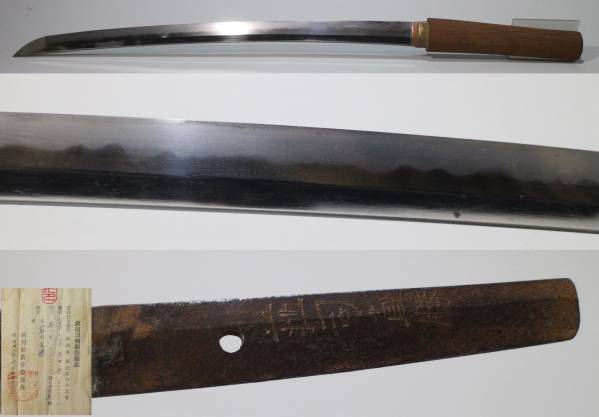
Wakidzasi, manufactured by the blacksmith (kaji) Taikei Naotane (1805 - 1858).
Tanto had a tsuba of normal size and looked like a smaller copy of a short sword. Aiguchi (literally “open mouth”) usually did not have a handle winding, so the stingray or shark skin that covered it was very visible. Without a tsuba, he did not have sepp's goals. It is believed that the samurai that were in the service wore the tanto dagger, and the ayguti — those who resigned (seemingly as proof that they are capable of something, because the dagger, even if it is without a guard, anyway dagger).
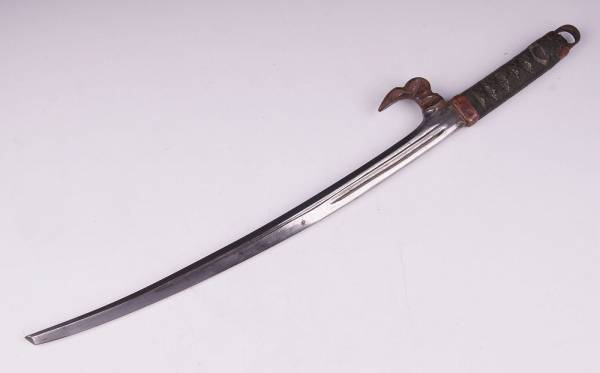
Kabutovari, the end of the XVIII-beginning of the XIX century
Kabutovari (the first hieroglyph “helmet” and the second hieroglyph “breaking”) is a forged metal curved baton with a pointed end and a sharp edge of Tosin, as well as dolom - hokoshi, kuichigai-hee with a small hook kagi at the base of the tsuki - handle. The latter protects the brush from the blows of the opponent, and everything else, when attacking the enemy, could cut the soft tissues of the body, even through kimono. The invention of this weapon is attributed to the legendary gunsmith Masamune.
They used samurai and the original look of the stylet - hativara, which, unlike its European counterpart, had a blade not straight, but curved, and even had a sharpening from the inner, concave side. With such thin blades, they pierced the armor of each other in hand-to-hand combat, but they also had double-edged blades with a dale attached to the traditional Japanese handle - yorodoshi-tantто, and its blade was very similar to the tip of the Japanese lance su-yari. Another "sharpened the opposite" pattern of Japanese bladed weapons was the dagger of the cubikir-zukuri. His blade had a greater curvature and also had a sharpening on the concave side, and the point was completely absent. The word "kubikiri" is translated as "head cutter", so its purpose is clear. These daggers were worn by servants of noble samurai, whose duty was to cut off the heads of dead enemies with his help, since they were "war trophies." Of course, that was how it was used in ancient times, but by the 17th century, the daggers of the cubikir-zukuri were worn mainly as a sign of distinction.
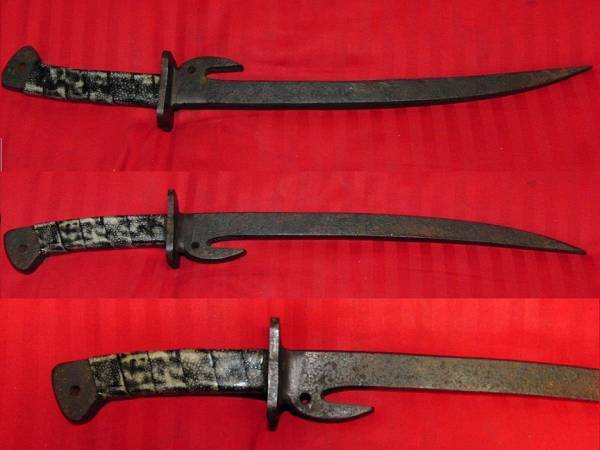
Hativa stiletto
Another purely Japanese weapon for self-defense were jute daggers. In fact, it was ... a rod with a handle, cylindrical or multifaceted, and without a pronounced tip, but on the side it had a massive hook. These weapons, moreover, usually a pair, were used by the Japanese police during the Edo period in order to disarm the enemy armed with the sword. With a blade and a hook, his sword was “caught”, after which it was pulled out or broken with a blow to the blade. A lanyard with a colored brush, the color of which determined the rank of a police officer, was usually attached to the ring on its handle. There were entire schools that developed in their walls the art of fighting in jutte and, in the first place, the techniques of countering this swordsman to a fighter with a samurai sword.
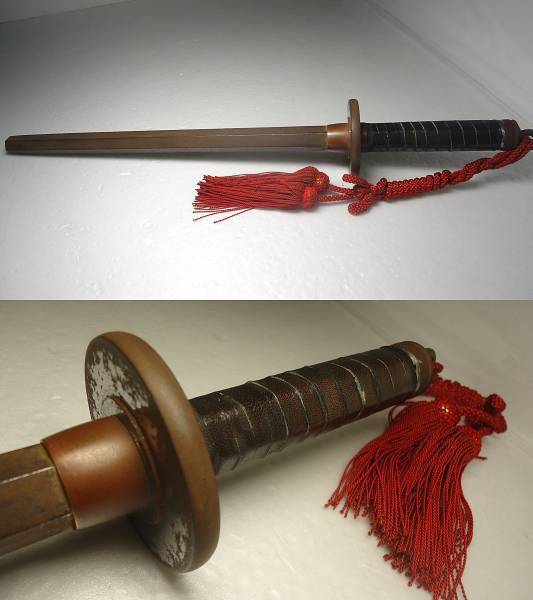
Police Stiletto Jyutte
Samurai’s weapon could even be a fan tessen, which could be used not only to give signals, but also to repel an enemy arrow or simply as a short baton, as well as a fighting chain - kusari with a weight at the end, an ax it and an ax Masakari.
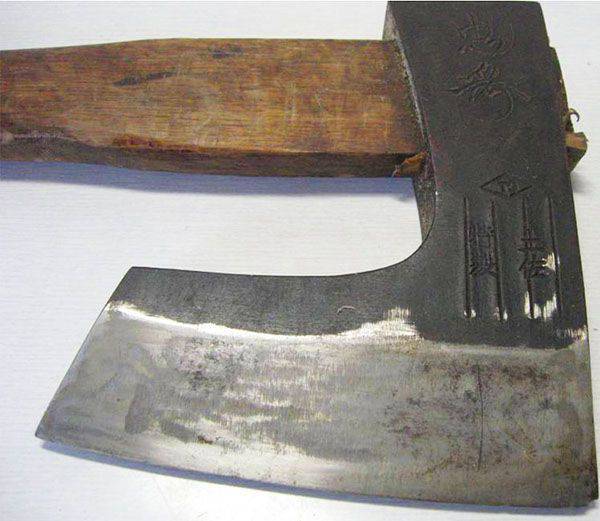
Masakari ax could be very similar to the medieval European ...
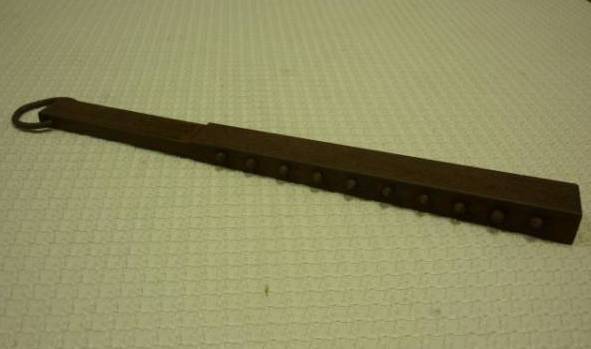
Fighting fan tessen was entirely made of metal and had the appearance of a folded fan. Except they could, with terrible force, unexpectedly hit the opponent on the head!
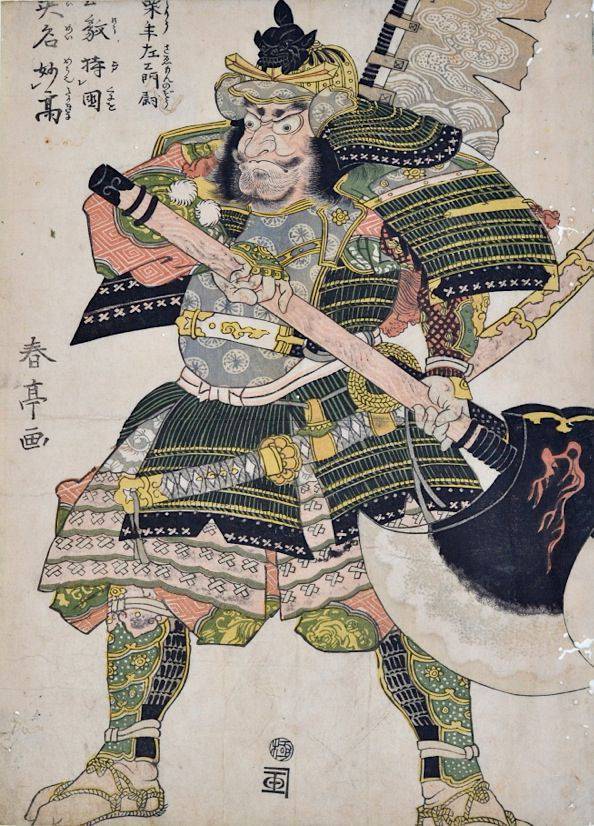
Samurai Saburo Yoshihide (XII century, died in 1213) - the famous warrior, son of Tomoe-Gozen and Wada Yoshimori, adviser to Minamoto-but Yoritomo. Notable for extraordinary strength, valor and courage. He is the hero of numerous legends, including stories about his descent into hell, about the conquest of the demons “They are Kigai ga Sima”, and about how he, in 1180, during the battle, tore a huge tree from the ground and used it as a weapon. Here and on this xylography, wanting to emphasize its power, the artist Katsukawa Syuntey (1770 - 1820) armed him with an ax, well, just of inconceivable size!
The latter types of weapons could have a grip almost as tall as a man, so it was quite difficult to use them, just like the “bearded” ax of the Anglo-Saxon xuslar 1066 of the year. But then their strike was most likely cut by any Japanese armor. Naturally, these weapons were used to break through the doors or gates in the fortifications of the enemy. Well, they were also used by mountain hermit warriors Yamabus, who lived in the forests and cut their way through the thickets.
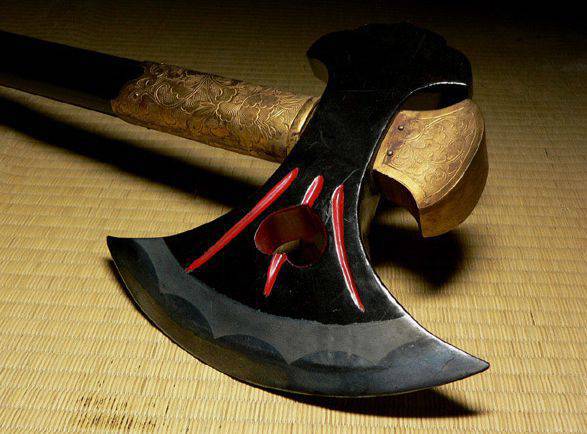
Yamabus Ax - it
But perhaps the most amazing weapon of the samurai was the wooden canabo mace, entirely made of wood or with iron spikes or nails, or without thorns, but with a faceted surface that resembled a modern baseball bat in shape and again almost as tall as a man!
A blow with such a club would leave the opponent very few chances and even the sword would not have helped him. It is interesting that, judging by the ancient Japanese prints, even if they are far away and cannot always be trusted, as the source, not only infantrymen fought with such clubs, but even horsemen! Intermediate between kanabo and tetsubo are such types of weapons as arareboi and neybo - even larger (more than two meters) sizes of cudgel, cubic or round in cross section of thickness 10-20 cm in diameter tapering to the handle. The legendary weapon of the busi is of the greatest power, since it is far from everyone to make swing movements with such a heavy object. The technique of working with neybo today is preserved only in the schools of kisin-ryu.
But the guards of the imperial palace had iron clubs, Cyricoba, which were most similar to scrap, so the saying “there is no reception against scrap” was obviously well-known to the Japanese even in ancient times. The war hammer in Japan was most of all like a big-bellied barrel impaled on a long handle. Usually this “barrel” was wooden and only occasionally was bound with metal. Unlike kanabo and kirikob, it was a weapon of commoners, but it’s not known how this division developed.
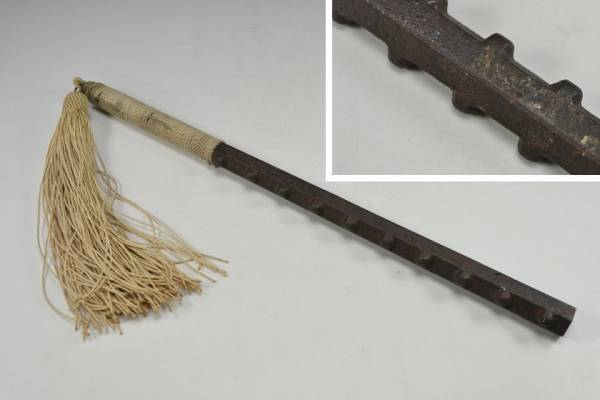
The mace of tetsubo - also made of metal and with blunt spikes was very short, no longer than a combat fan!
Although a mace similar to European and Middle Eastern designs in Japan was known, it was not very popular and the symbol of a military leader, as in Europe, was never considered! It should be noted that every samurai, in addition to everything else, had to be able to fight with a long wooden staff - bo, possession of which was equal to the ability to hold a spear and a halberd!
As for wick guns, the Japanese arquebuses were very different from European ones. Let's start with the fact that they had the opposite drive wick, the so-called gander. And the butt ... wasn’t attached to the chest at all while shooting! His hand pressed to the cheek, and recoil absorbed heavy barrel. In fact, it was ... a very long gun - that's how!
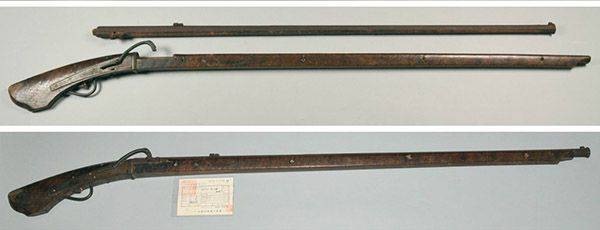
Tanegashima - Japanese wick gun, so named after the island, from where it spread to Japan. Caliber 12,5-mm. Above: separate trunk and box.

Wick trigger (gaff) and pilot hole. There is no cover for it on this sample.
Well, did the Japanese know pistols with short trunks? Indeed, in Western Europe, the knightly cavalry already in the same XVI century, replaced the cavalry of the latniki-pistoliers for whom precisely the pistols proved to be the ideal weapon. Yes, they knew, and they called the pistor spoiled by the European word. However, they were not widely spread among the Japanese. After all, they, too, were with wick locks. But if such a lock was convenient enough for an infantryman, he was no good for a rider, since he had to hold such a pistol with one hand, and what is most unpleasant is to constantly monitor the state of the wick glowing in it. In addition, the effectiveness of such cavalry has always been directly proportional to the number of pistols in each rider. In Europe, the pistol locks were wheel-mounted, and the pistoliers could have several of them at once: two in holsters near the saddle, another one or two behind the belt, and two more behind the boots of the boots. And they were all ready to shoot at once! In this sense, the Japanese wick pistol was no different from an infantry arquebus. Therefore, the rider could not have more than one such gun, and if so, then there was no point in it as a weapon. To master the mass production of a complex wheel lock, the Japanese at that time failed, although they made some of its samples. Hence all their problems with this type of weapon.
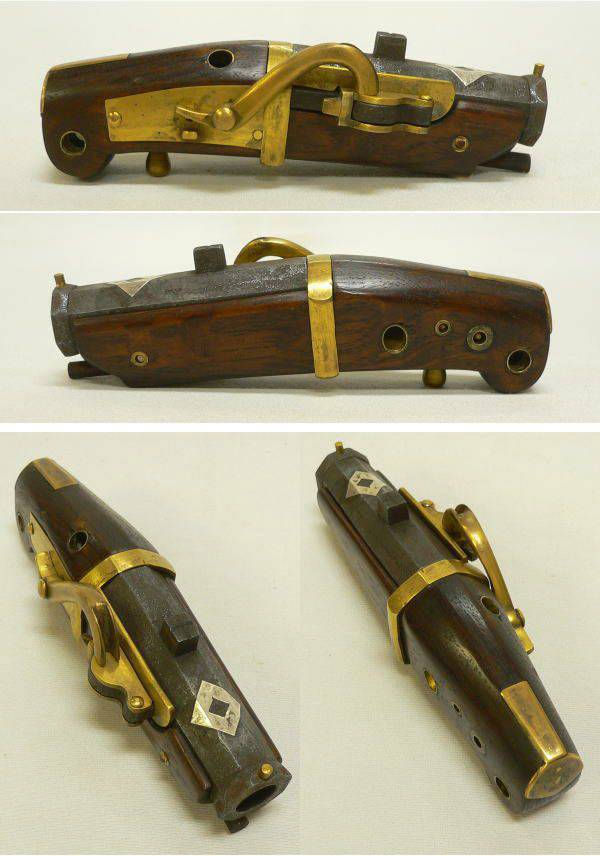
Wick Japanese pistol pistor (or tanju) with the image of a diamond on the trunk - the emblem of the clan Mayu.
Interestingly, in the West, although rarely, there were still combinations of a noble knight’s sword with a pistol, but in medieval Japan they were never joined together, although the combined weapon was known there, for example, a pistol-wakizashi, a pistol-pipe. But it was a weapon of people of noble rank. A real samurai could not use it without tarnishing his honor!
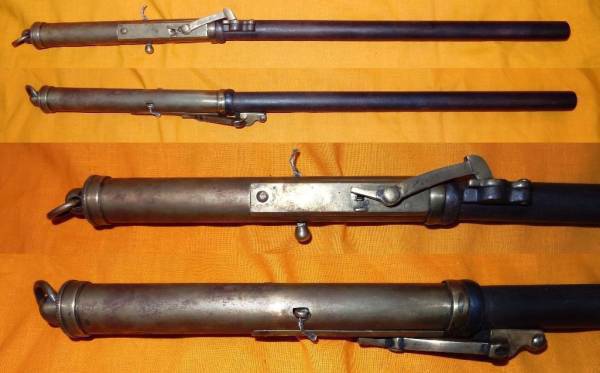
Japanese wick weapon teppo-jutte of the Edo epoch. Intended for concealed carrying. Weight 580
The Japanese knew about the invention in Europe in the second half of the XVII century bayonet bayonet, which was inserted with the handle into the hole of the barrel. There were two kinds of them: a sword-like dzuken and a spear-shaped juso. But they also did not spread because the improvement of firearms undermined the basis of the power of the samurai class and was very painfully perceived by the government and Japanese public opinion of the shogun era.
* The words “naginata” in Japanese are not inclined, but why not follow the norms of the Russian language in this case ?!
The author is grateful to the company.Japanese Antiques»For the information provided.
Information